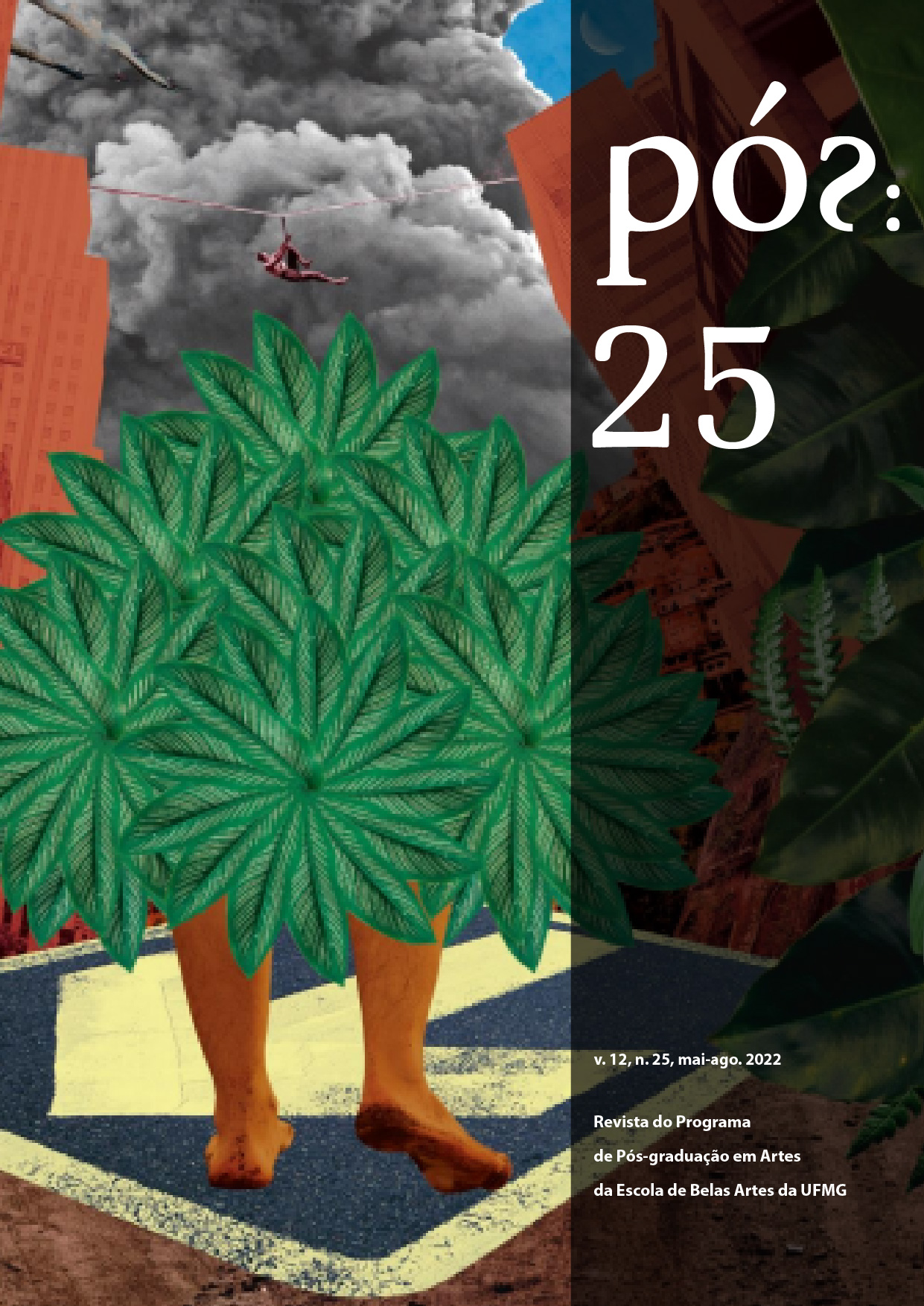Proposal of film analysis of actor’s performance
Wilson Grey, cameo-actor
DOI:
https://doi.org/10.35699/2237-5864.2022.35947Keywords:
Brazilian cinema., Acting studies, Aesthetics and film historyAbstract
This article aims to analyze the acting system in film of the Brazilian actor Wilson Grey according to the actor-author theory (McGILLIGAN, 1975), highlighting elements that make the actor’s work have an impression of thematic and formal constants. Grey has the ability to go through different phases of Brazilian cinema and, at the same time, maintain a coherent and uniform acting system, according to some premises that aim to break with the transparency of the classic performance and the claim of the citational and distant gesture, building a persona along the lines of movie stars, although he cannot be considered entirely one. This article aims to propose a methodology for film analysis that includes the actor at the center of reflections, broadening discussions based on issues related to image and narrative construction.
References
ABIRACHED, Robert. La crise du personnage dans le théâtre moderne. Paris: Gallimard, 1994.
ABISMU. Direção: Rogério Sganzerla. Brasil: Mercúrio Produções, 1974. Formato digital (80 min).
ÁGUIA na cabeça. Direção: Paulo Thiago. Brasil: Embrafilme, 1984. Formato digital (108 min).
AMEI um bicheiro. Direção: Jorge Ileli e Paulo Wanderley. Brasil: Europa Filmes, 1952. Formato digital (90 min).
ANCHIETA, José do Brasil. Direção: Paulo Cezar Saraceni. Brasil: Sant’Anna Produtora, 1977. Formato digital (140 min).
ASSALTO ao trem pagador. Direção: Roberto Farias. Brasil: Produções Cinematográficas Herbert Richers, 1962. Formato digital (102 min).
A COMÉDIA de Deus. Direção: João César Monteiro. Brasil: GER/Zentropa/Mikado/PGP/La Sept, 1995. (160 min).
A CONDESSA descalça. Direção: Joseph Mankiewicz. Estados Unidos; Itália: Fígaro, 1954. (128 min).
A DAMA do lago. Direção: Robert Montgomery. Estados Unidos: Metro Goldwyn Mayer, 1946. (105 min).
A DANÇA dos bonecos. Direção: Helvécio Ratton. Brasil: Grupo Novo de Cinema, 1986. Formato digital (90 min).
A RAINHA diaba. Direção: Antonio Carlos Fontoura. Brasil: Produções Cinematográficas R. F. Farias, 1974. Formato digital (99 min).
AS BODAS de Deus. Direção: João César Monteiro. Portugal; França: RTP/Madragoa Filmes/Gemini Films, 1999. Formato digital (150 min).
AS SETE vampiras. Direção: Ivan Cardoso. Brasil: Topázio Filmes, 1986. Formato digital (87 min).
BAR Esperança. Direção: Hugo Carvana. Brasil: CPC, 1983. Formato digital (127 min).
BARON, Cynthia. Modern Acting: The Lost Chapter of American Film and Theatre. New York: Palgrave Macmillan, 2016.
BARTHES, Roland. Introduction à l'analyse structurale des récits. In: BARTHES, Roland. Recherches sémiologiques: l'analyse structurale du récit. Paris: Seuil, 1966. p. 1-27. (Communications, 8).
BAZIN, André. Renoir français. Cahiers du Cinéma n. 8, p. 9-29, jan. 1952.
BERGALA, Alain. La non-direction d’acteurs selon Godard. Études Théâtrales, n. 35, p. 68-81, 2006. Disponível em: https://www.cairn.info/revue-etudes-theatrales-2006-1-page-68.htm. Acesso em: 8 jul. 2022.
BERGALA, Alain. L’acteur comme corps conducteur. In: Ontologia do ator cinematográfico, Jornada de Estudos Autorais do GRAC (Groupe de Recherche sur l’Acteur de Cinéma). Paris: Instituto Nacional de História da Arte, 2009.
BERNARDINO, Vanderlei. O ator do teatro de Arena no cinema novo. 2013. 92 p. Dissertação (Mestrado em Meios e Processos Audiovisuais) – Escola de Comunicação e Artes, Universidade de São Paulo, São Paulo, 2013.
CZACH, Liz. Acting and Performance in Home Movies and Amateur Films. In: TAYLOR, Aaron (org.). Theorizing Film Acting. New York; London: Routledge, 2012. p. 135-151.
DeCORDOVA, Richard. Genre and Performance: An Overview. In: GRANT, Barry Keith. Film Genre Reader III. Austin: University of Texas Press, 2003 [1986]. p. 130-140.
DeCORDOVA, Richard. The emergence of star system in America. In: GLEDHLL, Christine. Stardom: Industrie of Desire. New York; London: Routledge, 1991.
DEUS e o Diabo na Terra do Sol. Direção: Glauber Rocha. Brasil: Copacabana Filmes, 1964. Formato digital (120 min).
DYER, Richard. Stars. Londres: British Film Institute, 1979.
FEUER, Jane. O musical autorreflexivo e o mito do entretenimento. In: DUCCINI, Mariana et al. Gêneros Cinematográficos e Audiovisuais: Perspectivas Contemporâneas, vol. 3. Bragança Paulista: Margem da Palabra/Urutau, 2021 [1995].
GOFFMAN, Erving. Representação do eu na vida cotidiana. Petrópolis: Vozes (1975).
GUIMARÃES, Pedro. The Calculated Maladresse: Isabelle Huppert Dual Performance Style. In: REES-ROBERTS, Nick; WALDRON, Darren. Isabelle Huppert: Stardom, Performance, Authorship. London: Bloombury, 2021. p. 21-40.
LAURA. Direção: Otto Preminger. Estados Unidos: 20th Century Fox, 1944. Formato digital (98 min).
LEAL, João Vitor. A personagem no cinema: pessoa, figura e presença. Imagofagia: Revista de la Asociación Argentina de Estudios de Cine y Audiovisual, n. 24, p. 557-583, 2021.
MATAR ou correr. Direção: Carlos Manga. Brasil: Atlântida Empresa Cinematográfica do Brasil, 1954. Formato digital (87 min).
McGILLIGAN, Patrick. Cagney: the Actor as Auteur. London: Tantivity Press; South Brunswick: A. S. Barnes, 1975.
MONIKA e o desejo. Direção: Ingmar Bergman. Suécia: AB Svensk Filmindustri,1953. Formato digital (96 min).
MORIN, Edgar. As estrelas: mito e sedução no cinema. Rio de Janeiro: José Olympio, 1984 [1957]. p. 25.
MOULLET Luc. Politique des acteurs. Paris: Editions de l’Etoile/Cahiers du Cinéma, 1993.
NACACHE, Jacqueline. Le film hollywoodien classique. Paris: Nathan, 1995.
NAREMORE, James. Acting in the Cinema. Berkely/Los Angeles/London: University of California Press, 1988.
NEM SANSÃO nem Dalila. Direção: Carlos Manga. Brasil: Atlântida Empresa Cinematográfica do Brasil, 1954. Formato digital (90 min).
O BEIJO da mulher aranha. Direção: Hector Babenco. Brasil: HB Filmes, 1985. Formato digital (120 min).
O GIGANTE da América. Direção: Júlio Bressane. Brasil: Magnus Filmes, 1978. Formato digital (88 min).
O HOMEM do Pau Brasil. Direção: Joaquim Pedro de Andrade. Brasil: Embrafilme, 1982. Formato digital (106 min).
O LOBISOMEM, o terror da meia-noite. Direção: Elyseu Visconti. Brasil: Elyseu Visconti Produções Cinematográficas, 1974. Formato digital (36 min).
O REI do baralho. Direção: Júlio Bressane. Brasil: Júlio Bressane Produções Cinematográficas, 1973. Formato digital (81 min).
O SEGREDO da múmia. Direção: Ivan Cardoso. Brasil: Topázio Filmes, 1982. Formato digital (85 min).
O VAMPIRO. Direção: Luiz Rosemberg Fiho. Brasil: Luz Produções Cine, 1988. Formato digital (40min).
OS INCONFIDENTES. Direção: Joaquim Pedro de Andrade. Brasil; Itália: Bretz Filmes, 1972. Formato digital (100 min).
PARANAGUÁ, Paulo A. À la recherche d’un star-system. In: PARANAGUÁ, Paulo A. Le Cinéma Brésilien. Paris: Georges Pompidou, 1987. p. 199-211.
PISTOLEIRO bossa nova. Direção: Victor Lima. Brasil: Produções Cinematográficas Herbert Richers, 1960. Formato digital (111 min).
QUANDO o Carnaval chegar. Direção: Carlos Diegues. Brasil: Mapa Produções Cinematográficas, 1972. Formato digital (90 min).
RAMOS, Fernão; MIRANDA, Luiz Felipe (org.). Enciclopédia do Cinema Brasileiro. São Paulo: Senac,2010.
RECORDAÇÕES da casa amarela. Direção: João César Monteiro. Portugal: GER, 1989. Formato digital (122 min).
REPÚBLICA dos assassinos. Direção: Miguel Faria Jr. Brasil: Rima Filmes do Brasil, 1979. Formato digital (100 min).
SCHATZ, Thomas. Hollywood Genres, Formulas, Filmmaking and Studio System. Boston: MacGraw Hill, 1981.
STROMBOLI. Direção: Roberto Rossellini. Itália: RKO Radio Pictures, 1950. Formato digital (81 min).
UM FILME 100% brasileiro. Direção: José Sette. Brasil: Grupo Novo de Cinema, 1985. Formato digital (85 min).
VAI e vem. Direção: João César Monteiro. Portugal; França: Madragoa Filmes, 2003. Formato digital (175 min).
VIEIRA, João Luiz. A chanchada e o cinema carioca (1930-1950). In: RAMOS, Fernão; SCHVARZMAN, Sheila (org.). Nova História do Cinema Brasileiro: volume1. São Paulo: Edições Sesc, 2018. p. 344-391.
Downloads
Published
How to Cite
Issue
Section
License
Copyright (c) 2022 Pedro Maciel Guimarães Junior

This work is licensed under a Creative Commons Attribution-NonCommercial 4.0 International License.
Authors who publish in this journal agree to the following terms:
- Authors retain copyright and grant the journal the right of first publication, with the work simultaneously licensed under the a Creative Commons Attribution-NonCommercial 4.0 International License that permits sharing of the work with acknowledgement of authorship and initial publication in this journal;
- Authors are permitted to enter into additional contracts separately, for non-exclusive distribution of the version of the work published in this journal (e.g., the Creative Commons Attribution License).
- Authors are permitted and encouraged to publish and distribute their work online (e.g., in institutional repositories or on their home page) at any point before or during the editorial process, as this may generate productive changes as well as increase the impact and citation of the published work.
- It is the responsibility of the authors to obtain written permission to use in their articles materials protected by copyright law. Revista PÓS is not responsible for copyright breaches made by its contributors.












